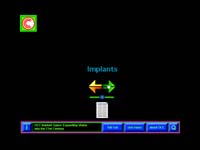
documents the ongoing work of the virtual Ocular Convergence Consortium, an international consortium of government and private organizations, corporations, and research groups dedicated to visual and perceptual enhancement and integration in the 21st century. OC members are centrally concerned with the uses of ocular implants within networked systems. Represented in the OC consortium are some of the world's top corporations and researchers working on vision enhancement in fields including optics, prosthetics, genetics, and entymology. The OCC was formed in June of 1999 at the annual meeting of the Visual Integration Society (VIS). The conference theme, Global Vision in Crisis, was selected in response to the World Health Organization alert concerning the global decline in ocular health and function.
The WHO identified environment and technological factors as significant contributors to this crisis. Some of the factors noted in their report are erosion of the ozone layer; an aging first-world population (resulting in an increase in age-related ocular diseases sharing the anatomical problem of rod and cone degeneration); and evidence of increases in lenticular diseases in third world regions. We would add to this list an increased reliance on visual labor and a growing demand for visual acuity in the global workforce. OC members are responding to these factors by providing a resource for sharing technology and knowledge across institutional borders, with an eye to more rapid development of viable technologies for optimizing human vision.

